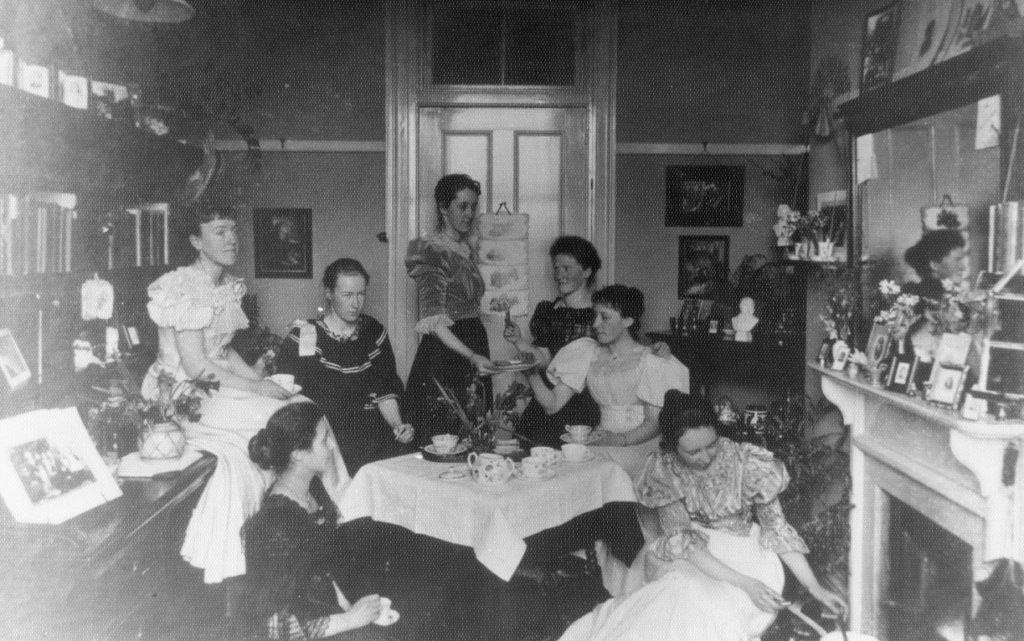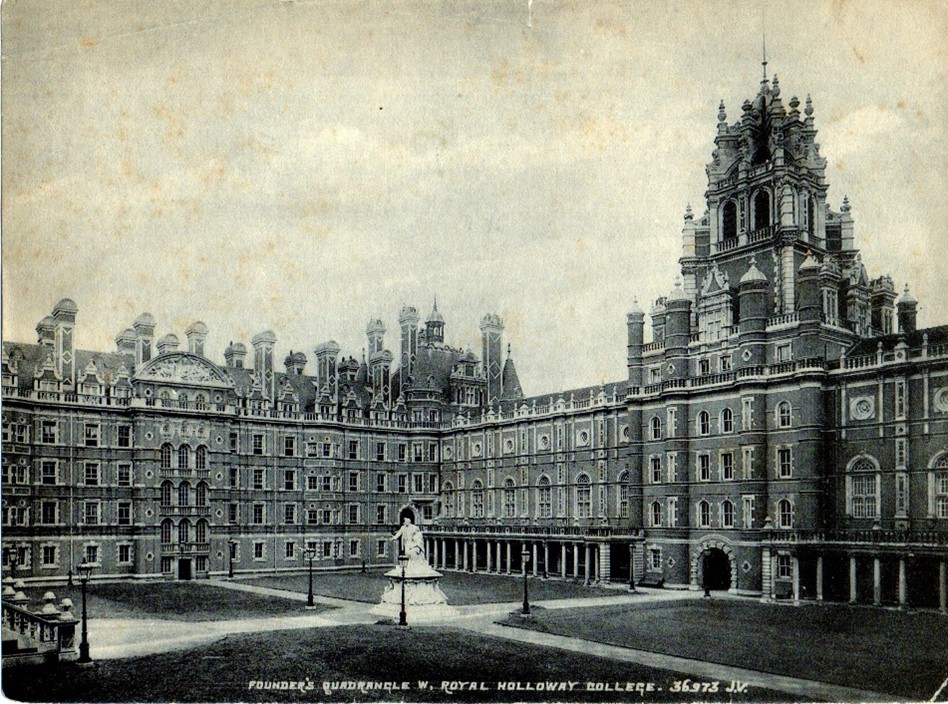She Was Not Alone: Royal Holloway’s Suffragist and Suffragette Alumnae
When we think of the fight for women’s suffrage, one image often stands out in our minds. We imagine a Suffragette running out onto the track at the Epsom Derby in 1913 and being hit by the King’s horse. We know her as the Suffragette’s most famous martyr. Emily Wilding Davison is probably the most famous Suffragette of all, and also the most well-known alumna of Royal Holloway University. Yet, she was not the only woman who had a connection with Royal Holloway who contributed to the campaign that won women the right to vote.
Queen Victoria opened Royal Holloway College in 1886. Fourteen years later, the college became part of the University of London. Significantly, Royal Holloway would only educate women until 1965 when the university became co-educational.
Louisa Martindale
Louisa Martindale was born in 1872 and attended Royal Holloway College, as it was known then, between 1890 and 1893. After becoming a doctor, she became the first woman GP in Brighton and established the New Sussex Hospital for Women while also being a member of the Brighton and Hove National Union of Women’s Suffrage Societies (NUWSS). She was also a member of the Royal Holloway College Suffrage Society (Old Students). In 1934 she became president of the National Council of Women in Brighton and Hove. She specialised in treating ‘fibroid uterus conditions and breast cancer’ and used radium as a treatment for ‘cervical and ovarian cancer’. In 1931, the year she was awarded a CBE, she petitioned the House of Lords to improve women’s access to the medical profession. She retired in 1947, after working throughout the Second World War, and it is thought that she carried out more than 7,000 operations over her career. She died in 1966 at the age of 93.
Mary Thompson
Mary Thompson was born in 1866 in Northumberland and attended Royal Holloway College between 1889 and 1892. She studied Latin and graduated with a distinction and the ‘Driver Prize for Latin Prose’. Mary became a teacher and, in 1904, she became a member of the NUWSS. Mary also took part in Suffragette activities, as in February 1912 she was arrested on Oxford Street for playing a barrel-organ (a small, portable organ) after refusing to pay a fine. However, she did not go to prison as Thompson’s employer gave her the money to pay the fine. She later joined the United Suffragists alongside the Suffragette Fellowship demonstrating that women did not have to be either a Suffragist or Suffragette. She died in 1960, aged 94.
Rose Yates
Rose Yates was born in 1875 in Brixton. She first attended Royal Holloway College in 1896 and studied modern languages, although she did not complete her final year. She joined the committee of the Women’s Social and Political Union (WSPU) in Wimbledon in 1909. On 24 February of that year, Rose was arrested after demonstrating outside the House of Commons and was sentenced to one month in prison. Her husband, Tom, had defended her during her trial, and she had to leave her eight-month-old son.
In a 1909 edition of Punch, Yates is quoted as saying “I have a little son, eight months old, and his father and I decided, after calm consideration, that when that boy grew up her might ask, ‘What did you do, mother, in the days of women’s agitation, to lay women’s grievances before the Prime Minister?’ and I should blush if I had to say I made no attempt to go to the Prime Minister.” It is clear that Yates felt that it was her moral responsibility to take part in the ‘agitation’ and make her voice heard for the benefit of future generations. However, Punch magazine did not share her views and responded with a mocking poem:
‘Let it be his to hear the tale – and may be
It will not lose through being often told –
How you renounced your husband, home and baby,
When he (the last-named) was but eight months old.
Such be your answer! Yet, O happy mother,
Is this the only question you forsee?
What will you say, suppose he asks another: –
“Meanwhile, dear Parent, who looked after me?”’
Punch, 1909.
Punch magazine did not see Yates as an inspirational figure, as we do now, but as a careless mother who had abandoned her child. She had abandoned all that defined her as a woman, her ‘husband, home and baby’. However, her husband was a member of the Men’s Political Union For Women’s Enfranchisement and was arrested in 1911 after demonstrating, therefore sharing her views on the fight for women’s suffrage.
Yates helped to run the Wimbledon WSPU shop, growing fruit, vegetables, and flowers to sell. There was also a meeting room connected to the shop, and Emily Wilding Davison was a ‘regular’ speaker at these sessions. Her husband would act as legal counsel for WSPU members who had been imprisoned, and represented Davison’s family at the inquest following her death. When Davison’s coffin was carried from Epsom to King’s Cross, Yates was the “first guard of honour” in the procession. In the issue of The Suffragette that was published following Davison’s death, Yates wrote a tribute for her ‘old college friend’. While these women did not attend Royal Holloway at the same time, in Yates’ eyes, it bound them together. Yates was also instrumental in the creation of the Suffragette Record Room, which preserved the Suffragettes’ documentation and moved the ‘relics’ to safety during the Second World War. Yates died in 1954 at the age of 79.

This photo is featured in ‘The Mystery of the Missing Suffragette’.
Dora Mason
Alumnae weren’t the only ones working for women’s suffrage. Dora Mason was born in 1882 in Bexleyheath. She was an assistant lecturer at Royal Holloway College between 1904 and 1905, and taught Classics. She became the head of the Oxon, Berks and Bucks Federation of NUWSS and in 1915 formed a suffrage summer school in St Andrews. After the First World War, Mason became a doctor, working as a GP in Bedford. She also became the president of the National Council of Women in Bedford in 1930. Mason died in 1978. She was 96 years old.
Royal Holloway College (Old Students)
Many more alumnae would have been members of the Royal Holloway College (Old Students) branch of the NUWSS. While students were attending Royal Holloway, they could not take part in the campaign for women’s suffrage. This was due to a resolution passed in May 1908 at the Student’s Meeting that forbade ‘the use of the name Holloway in the matter at all’. This is why the NUWSS branch was for old students only, as current students could not align themselves with either the Suffragists or the Suffragettes. While we see Davison as a hero today, indeed the library at Royal Holloway is named after her, many at the time did not share this view. She was viewed as a disgraced and dangerous woman. Her fellow Suffragist and Suffragette alumnae would have been viewed in a similar way.
You can explore Royal Holloway in 1913 in ‘The Mystery of the Missing Suffragette’.
It is not by accident that Davison is the most famous Suffragette. She was made into a martyr by the WSPU following her death, even though Mary Clarke (Emmeline Pankhurst’s sister) had died in 1910 after being released from prison. As Elizabeth Crawford notes, ‘her death came at a time when militancy was reaching a crescendo.’ While it is important to remember Davison, we must also remember and be grateful to those other Royal Holloway alumnae and staff who fought for women’s suffrage by all manner of means. Royal Holloway alumnae contributed greatly to the Suffragette’s cause, but they played an equally important role in the Suffragists non-militant campaign.
Read the next blog to discover what militant action the Suffragette’s undertook and how we perceive their actions today.
Travel back to 1913 by playing the free online puzzle game ‘The Mystery of the Missing Suffragette’ to learn more about Emily Wilding Davison. Visit Royal Holloway and Egham, attend The Egham and District Women’s Suffrage Society meeting, and use your puzzle-solving skills to uncover the truth about “Mary Dean”. This game is suitable for ages 14 and over.
Further Reading:
Elizabeth Crawford, The Women’s Suffrage Movement A Reference Guide 1866-1928 (1999).
Women’s Suffrage and Royal Holloway College, Exploring Surrey’s Past, https://www.exploringsurreyspast.org.uk/royal-holloway-suffrage/
Punch Verse Rose Lamartine Yates, Wikemedia Commons, https://commons.wikimedia.org/wiki/File:Punch-verse-rose-lamartine-yates.jpg

